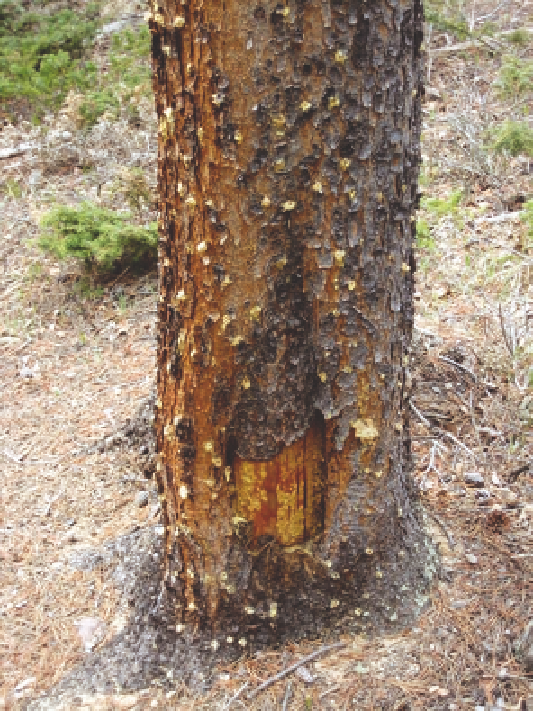Geoscience Reference
In-Depth Information
mortality and combustion of organic matter. Severity
ranges from surface fires that only consume a portion
of the forest floor and kill small trees, without harm-
ing most larger trees, to high-severity stand-replacing
crown fires that kill most of the trees and consume
essentially all of the forest floor. Forest fires typically
burn in a highly heterogeneous manner, responding
to wind direction, slope and aspect, and variation in
local weather and fuel conditions. the result is a mosaic
of severely burned patches, light or moderately burned
patches, and unburned forest.
28
each tree species has adaptations that enable it to per-
sist in the face of periodic disturbance, and each major
forest type tends to be characterized by a different kind,
frequency, and severity of disturbance. For example,
the thick bark of mature ponderosa pine and Douglas-
fir trees protects the critical inner bark tissues from heat
injury and enables these trees to survive low-intensity
surface fires—which historically were the most com-
mon type of fire in many low-elevation ponderosa pine
and Douglas-fir forests. However, all conifers are killed
by fires that burn through the crowns of the trees, a
common type of fire in montane and subalpine forests.
Lodgepole pine is well adapted to such high-severity
fires, because even though the adult trees are usually
killed, each tree often has hundreds of cones that store
large numbers of viable seeds. At least some of the seeds
survive even an intense fire, as discussed later in this
chapter. these seeds germinate and grow best on the
bare soil exposed by a severe fire. Aspen also persist in
burned forests, despite fire killing all the aboveground
portions of the tree, because its roots usually survive
and produce abundant new sprouts that grow rapidly
into new trees. Soil is an excellent insulating material
for the roots.
Fires also affect animal abundance and distribution
patterns. For example, three-toed and black-backed
woodpeckers typically nest and reproduce in conifer-
ous forests that have recently burned or been affected
by bark beetle outbreaks, because the insects inhabiting
the dead or dying trees provide an abundant and read-
from the greater abundance of herbaceous or shrubby
plants after such disturbances, and raptors are drawn
to disturbed forests because rodents and other prey are
Bark Beetle Outbreaks
Rapid increases in the populations of some insect species
can lead to major disturbances that change forest struc-
insect most often mentioned as a disturbance agent in
Rocky Mountain forests, but other species of bark beetle
are also involved, each specializing in feeding on a par-
ticular tree species or group of species. these include the
Douglas-fir beetle, spruce beetle, and western balsam bark
beetle (which kills fir trees). All are natives. Defoliating
insects, notably the western spruce budworm and aspen
tent caterpillar, also modify forests. Because bark beetles
have had such dramatic effects over such extensive areas
Fig. 11.6. numerous spots of resin and yellow sawdust on
the bark indicate that this lodgepole pine has been invaded
successfully by mountain pine beetles. each spot represents
the entrance of one beetle. the beetles introduce the blue-
stain fungus that soon plugs the sapwood, causing tree death
within a few months. the leaves are reddish-brown by the
following summer (as illustrated in figs. 16.4 and 16.9 for
infested ponderosa pine). this pine also has a scar on the
trunk, possibly caused by a porcupine if not a fire.

Search WWH ::

Custom Search